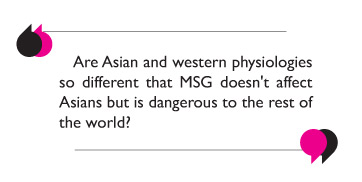
When people write about Thai cuisine, they usually include the “four pillars” that constitute the building blocks of Thai cooking. This taste foundation consists of sweet, salty, sour and hot flavours. I’ve watched my wife, and others, prepare Thai food for many years and all of these ingredients are present, in greater or lesser amounts, in almost every savoury Thai dish. Thai cooks frequently add a fifth ingredient – MSG. It is used so frequently that it must be considered the fifth pillar of Thai cooking.
In school we all learned that there are four primary taste receptors on the tongue – salty, sweet, sour and bitter. Recently a fifth type of receptor has been identified and accepted (by whatever organisation makes such decisions). These receptors react to glutamate salts and produce a pleasant, savoury taste named umami. Garum, a fermented fish sauce was used by the ancient Romans and is high in glutamate salts. The Chinese add Chinese leek and cabbage with chicken soup, and Italians combine Parmesan cheese on tomato sauce with mushrooms. The umami taste sensation of those ingredients mixed together surpasses the taste of each one alone. Foods naturally high in umami are Marmite, mother’s milk, fish, shellfish, cured meats, vegetables (e.g., mushrooms, ripe tomatoes, Chinese cabbage, and spinach), green tea and fermented and aged products (e.g., cheeses, shrimp pastes, soy sauce, etc.) Wikipedia has a good discussion of umami.
MSG gets a bad rap in the western world. The MSG brouhaha started in 1968 when Dr. Ho Man Kwok published an article about ‘Chinese Restaurant Syndrome (CRS)’. From this article, many people jumped on the anti-MSG bandwagon. Self reported negative physical reactions to eating it include headache, seizures, asthma, and depression. See this site for the argument against consumption of glutamic acid (http://www.advanced healthplan.com/msgstudy.html). They claim that 25% of people have negative reactions to MSG.

Two lines of reasoning lead me to conclude that MSG, as normally consumed, is no more harmful than sugar or salt. Research results in Australia and America report that less than 1% of the population has negative, transient reactions to MSG ( http://en.wikipedia.org/wiki/Monosodium_glutamate ). This conclusion was based on properly designed, properly conducted and properly analysed research. Secondly, as Jeffrey Steingarten, the great American Vogue writer noticed: “If MSG is bad for you, why doesn’t everyone in China have a headache?” MSG is used daily in China, Japan and Thailand and has been for centuries. Are Asian and western physiologies so different that MSG doesn’t affect Asians but is dangerous to the rest of the world?
My advice is, unless you’ve experienced CRS in the past or have been clinically tested for sensitivity, don’t stress about MSG and enjoy the fifth pillar of Thai cuisine.